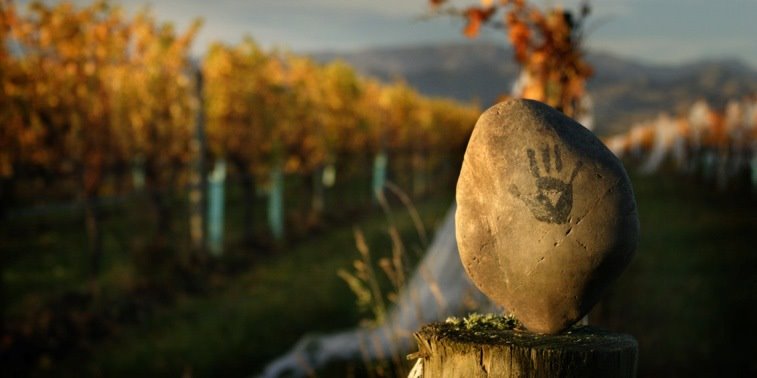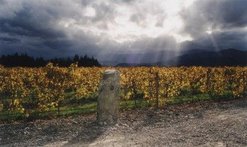The first day of this past descending moon we began our composting in earnest. Quite a feat at the scale we undertake but nevertheless all of our energy and enthusiasm goes into it, as this will be the life and nourishment that graces our land for the next year. We give life to an otherwise disconnected, physically separate set of materials by gathering and assembling these elements of life and inserting our biodynamic preparations. We started bringing them together months ago. Some woodchips from a local sawmill; chipped up willow from along our creek; hay grown in our paddocks; manure from our favourite dairyman; grape marc (skins and stems) and olive pomace (pulp and pits) from our organic and biodynamic estate; gorse and broom cut and mulched from our terraces; coffee grounds and egg shells gathered from local cafes. Like a squirrel stocking up for winter, we too have been preparing by gathering all the ingredients to give us a wonderful steaming compost pile blessing us with riches for the spring.
 We make three types of compost, each slightly different to suit the needs of the land that we will use them on. Our primary compost piles are quite large and will be used on our grapes and olives. They consist of layers of straw, grape marc, lime and reactive rock phosphate (RPR), wood chips, manure slurry, green manure, coffee grounds, crushed egg shells, etc. Here is a picture of a cross-section of a compost pile where you can see an example of some of the layers.
We make three types of compost, each slightly different to suit the needs of the land that we will use them on. Our primary compost piles are quite large and will be used on our grapes and olives. They consist of layers of straw, grape marc, lime and reactive rock phosphate (RPR), wood chips, manure slurry, green manure, coffee grounds, crushed egg shells, etc. Here is a picture of a cross-section of a compost pile where you can see an example of some of the layers.
We have a separate compost pile that will be used in the making of our compost teas. We need this one to be very fungally active so we use more woody materials. The compost that we use for the gardens needs to be more bacterially dominant, so we use less wood and more green matter and food scraps.
Our favourite part of making compost is when we get to use our latest invention – “the slurryator 9000” – to spray manure that has been mixed with water into a slurry onto the pile. Great fun! 
All of our compost piles have the biodynamic compost preparations added to them (502-507), temperatures regularly monitored and are turned when the drop to 40ºC, after having risen to 60ºC+. A second round of the biodynamic compost preparations are added when we turn the compost.
 We add the compost preparations to the pile by making small balls of cowpat pit, inserting each preparation into one ball, making a hole in the pile with a steel rod and inserting the balled up preparation as far as we can, literally up to our elbows! We do this for preparations 502-506 (yarrow, chamomile, stinging nettle, oak bark, dandelion), but we mix preparation 507 (valerian) with water, stirring it for 10 minutes, creating vortices, and then pour it into holes on the top of the pile and sprinkle it into each of the holes we made when inserting the other prep
We add the compost preparations to the pile by making small balls of cowpat pit, inserting each preparation into one ball, making a hole in the pile with a steel rod and inserting the balled up preparation as far as we can, literally up to our elbows! We do this for preparations 502-506 (yarrow, chamomile, stinging nettle, oak bark, dandelion), but we mix preparation 507 (valerian) with water, stirring it for 10 minutes, creating vortices, and then pour it into holes on the top of the pile and sprinkle it into each of the holes we made when inserting the other prep arations.
arations.
The primary reason that we make compost is to create a nutritionally and biologically rich substance to nourish our lands and attempt to replace what was harvested from the land this season. It is also a way for us to spread our biodynamic preparations as we apply the compost and use it in our compost tea. We believe composting is a good way to recycle materials that would otherwise be considered waste, for example our grape marc and olive pomace which are rich in nitrogen; coffee grounds which are also rich in nitrogen; and egg shells that are high in calcium.
Here is the first of our creations, approximately 1.4m wide by 1.2m high by 34m long! We added 12 sets of our biodynamic compost preparations (502-507), which gave us about 1 set per 5 cubic meters of compost. That’s 60 ‘up to your elbows’ into the pile plus the valerian!
 Writing for the Times in the UK, wine critic Jane MacQuitty had some lovely things to say about Seresin's 2006 Leah Pinot Noir.
Writing for the Times in the UK, wine critic Jane MacQuitty had some lovely things to say about Seresin's 2006 Leah Pinot Noir.



















































.jpg)